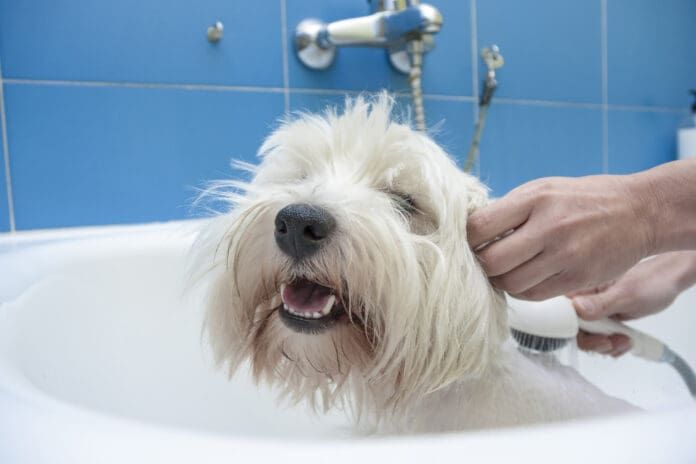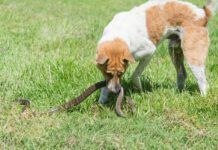A single flea on your dog may not look like an infestation, but it could become one soon. The fastest way to remove fleas from your dog is with a bath, and you probably already have what you need to put together a homemade flea shampoo.
The basic ingredient in any shampoo is soap, and you can use anything from a liquid dish soap (look for sensitive-skin formulas) to baby shampoo or a castile soap containing olive oil, coconut oil, jojoba oil, or other moisturizing oils. These limited-ingredient, chemical-free, gentle lathering soaps will release fleas, flea eggs, larvae, and flea dirt from your dog’s hair without irritating his skin. Fleas cannot float in soapy water, so they drown when the surfactants in soap immobilize them.
One popular addition to homemade flea shampoo for dogs is white or apple cider vinegar, but while it helps relieve itchy skin, vinegar does not kill adult fleas, flea eggs, or flea larvae and it isn’t an effective flea repellent. Consider vinegar an optional ingredient that may help relieve itching and improve your dog’s coat.
If you think your dog might have fleas but you aren’t sure, do a simple test with a flea comb and a damp paper towel. Brush your dog’s dry coat with a flea comb, which has narrow teeth that capture loose hair and debris that’s caught in the hair. Remove loose hair on the damp paper towel and look for small black specks. If they turn rusty red on the white paper towel, they are flea droppings containing your dog’s blood. If you see live fleas in the loose hair you comb, simply pull the hair off the comb in a plastic zipper bag and seal it closed.
Oatmeal, aloe vera, and vegetable glycerin are additional skin-soothing ingredients that help if flea bites leave your dog scratching. Baking soda (bicarbonate of soda) can be added to shampoo to help neutralize unpleasant odors and soothe the skin.
Several aromatherapy essential oils repel or help kill fleas. The essential oils of lavender, peppermint, cedar, lemongrass, and eucalyptus have this effect and are safe to add in small amounts
Building a Recipe
Start with 2 cups of warm water.
Add 1 cup of nontoxic liquid soap.
This is your flea shampoo’s foundation. Even with no other ingredients, this blend can wash away fleas, their eggs, and the droppings fleas leave behind.
Optional Ingredients
If desired, add any of the following to your basic shampoo:
- 1/2 cup white or apple cider vinegar
- 1/2 cup vegetable glycerine
- 1/4 cup aloe vera gel
- 1/2 cup finely ground oatmeal
- 1/4 cup baking soda
- 1/2 cup fresh lemon juice
- 4 drops essential oil
Start with just one or two optional ingredients, mix well, and bathe your dog. With such simple, safe ingredients, it isn’t necessary to wear protective gloves. Experiment with other combinations for future baths until you find a favorite blend. Your ideal consistency is thin rather than thick, so dilute the mixture with extra water if needed. Sudsy foaming isn’t required; what’s important is that the mixture reaches all parts of your dog. Be sure to keep the shampoo from getting into your dog’s eyes, ears, nose, or mouth.
Bathing Your Dog
As described in How to Bathe Your Dog and Tips for Giving a Dog a Bath at Home, organize towels, shampoo, and other equipment, then:
- Brush your dog with a dry brush to remove tangles.
- Wet your dog to the skin.
- Apply shampoo, starting at the neck, and cover the entire body.
- Work the soap into your dog’s hair with your fingers or with a rubber or silicone bath brush.
- Leave the shampoo on your dog for 5 to 10 minutes before rinsing.
This last step is important for killing fleas, and you can make it more comfortable for your dog by gently massaging her coat while waiting. Fleas do their best to escape, so be ready to rinse and remove adult fleas as they climb onto your dog’s head or onto you. Rinse thoroughly, then towel your dog. If desired, dry with a blow dryer set on low heat. Finish by brushing your dog’s hair while it’s still slightly damp.
Optional: Add a Rosemary Rinse
Because the herb rosemary repels fleas and helps improve the condition of a dog’s coat, rosemary tea is an appropriate final rinse after bathing. To brew it, place 2 cups of loosely packed fresh rosemary in 3-quart (or larger) saucepan. If you don’t have fresh rosemary, substitute 1/2 cup dried rosemary sold as a culinary herb. Add 2 quarts of water to the pan, cover it, and bring the pan to a boil. Reduce the heat and gently simmer the rosemary for an hour, then let the covered pan cool to room temperature. Strain stems and leaves by pouring the tea through cheesecloth or a wire mesh strainer. Apply the tea full-strength to your dog’s wet coat after bathing, working it well into your dog’s skin, especially around the base of the tail, under armpits, and around the neck. Distribute the tea evenly with a bath brush or your fingers, then let it air-dry. The tea can also be sprayed onto your dog’s dry coat between baths and worked in with your fingers or a brush. Rosemary tea can be refrigerated for up to one week.
Apply a Tonic Skin Lotion
In his book Dr. Pitcairn’s Complete Guide to Natural Health for Dogs & Cats, holistic veterinarian Richard Pitcairn, DVM, recommends a treatment from animal herbalist Juliette de Bairacli Levy, who created a skin tonic for severe flea infestations and the skin discomforts they cause. To make it, thinly slice two whole lemons, including the peel. Place the slices in a quart jar and cover them with at least 2 cups of boiling water. Let the jar stand in a warm place or in direct sun for two days. For a stronger lotion, add an additional lemon, wait another two days, and squeeze the lemons or shake well to release all of the juice and the skins’ essential oils. Apply the lotion to your dog’s skin with a sponge or washcloth, work it in well, and let it air-dry. Repeat the application daily as needed. As Dr. Pitcairn explains, lemon lotion “is a source of natural flea-killing substances such as d-limonene and other healing ingredients.”
Introducing Neem Oil
Neem oil is pressed from seeds and fruit of the neem tree (Azadirachta indica), which grows in India, where it has been used medicinally for centuries because of its antibacterial, antiseptic, and antifungal properties. As a bonus, it kills or repels biting insects like fleas, mites, and mosquitoes. When selecting a neem oil for use on your dog, choose a pressed rather than extracted oil. To 1 fluid ounce (2 tablespoons) shampoo add 1 teaspoon neem oil and follow the bathing instructions above.
Check the Environment
If your dog has fleas, be sure to treat the areas where she spends time. These areas should be thoroughly cleaned, cleared, or vacuumed, and her bedding should be washed.
Between-Bath Maintenance
Between baths check your dog’s dry coat for flea dirt. A flea comb can remove up to 60% of the flea eggs on a dog along with flea larvae, so if your dog is comfortable being combed, spend a few minutes removing those threats. If your dog shows signs of new fleas, give another bath.





